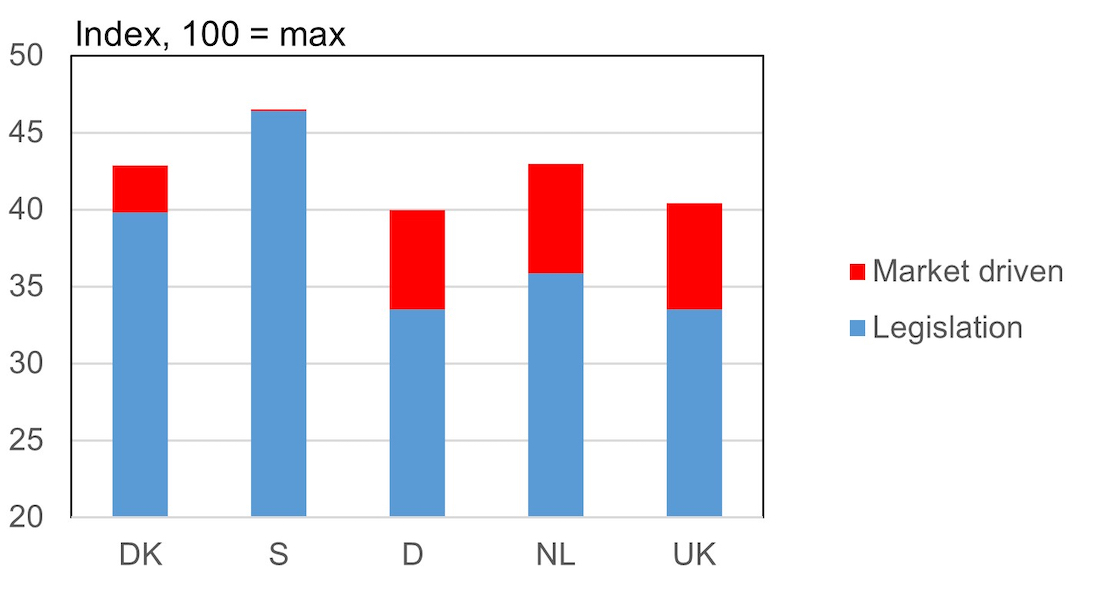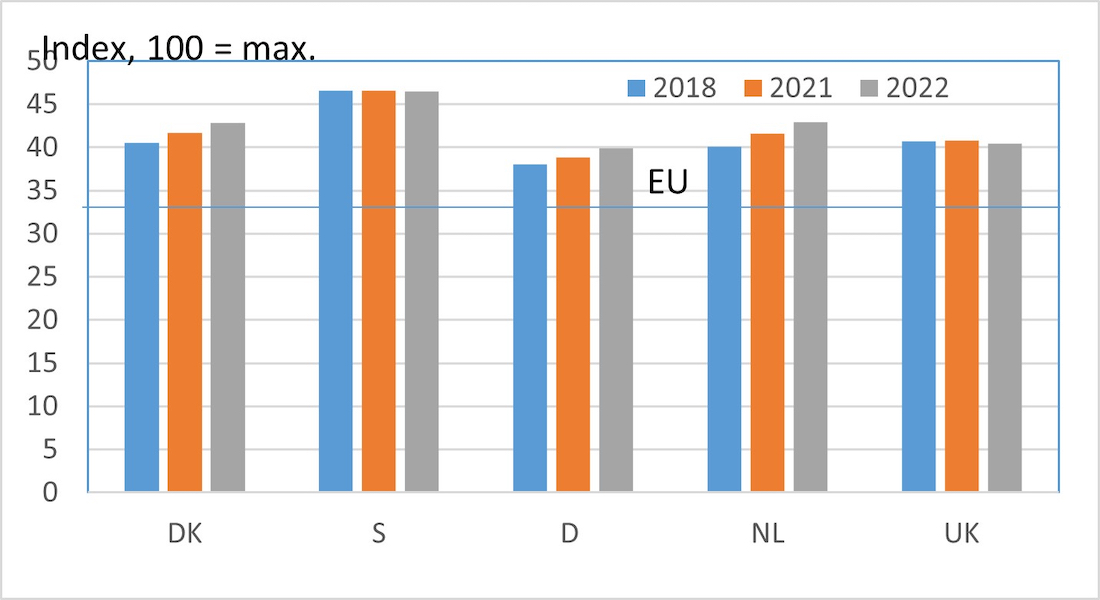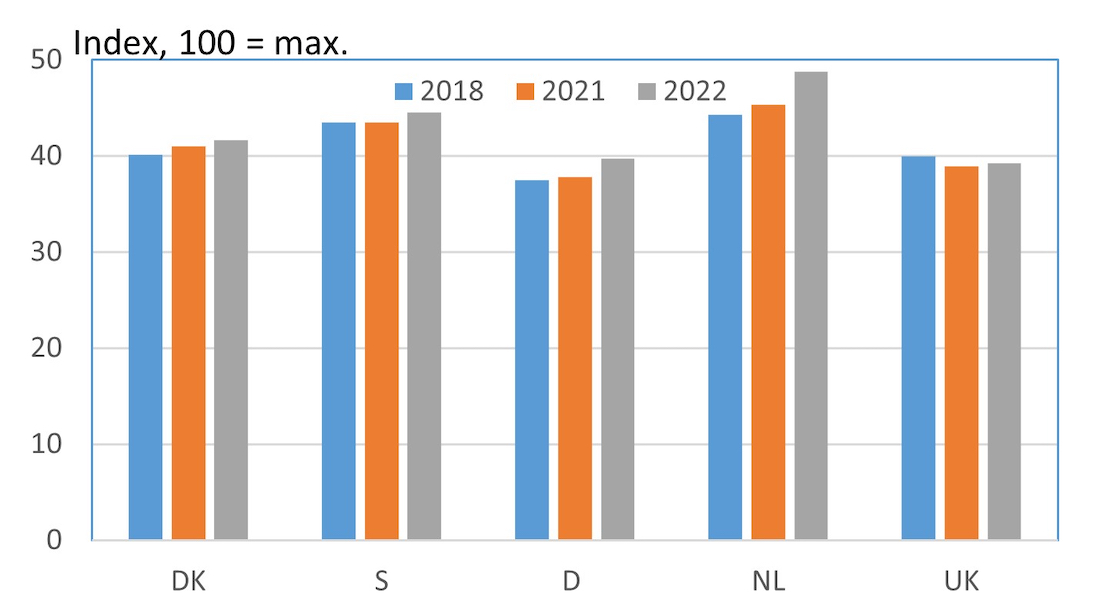Benchmark for broiler chickens 2022
Most important messages from the figure
- There are cross-country differences in opportunities for good welfare offered to broilers chickens. The higher the Benchmark value, the better the opportunities. Denmark is at placed in the middle, both in terms of national production and national consumption of chicken meat. Sweden does better in terms of both production and consumption, while the Netherlands do better in terms of consumption.
- Market-driven initiatives have had a relatively large effect on the Benchmark values in some of countries. This becomes clear when comparing Sweden and the Netherlands. In Sweden, legislation is fairly extensive in ensuring broiler welfare in national production. In the Netherlands, on the other hand, market-driven initiatives have resulted in a Benchmark value for national production above the EU requirement. Moreover, the Benchmark value for national consumption is higher than in Sweden. Due to these market-driven initiatives, all fresh chicken meat sold in Dutch supermarkets stem from slower growing broilers. The situation in Denmark resembles the situation in Sweden. In Denmark, relatively high legislative standards combined with nationally produced welfare broilers are counteracted by the imports of very cheap chicken meat produced with lower animal welfare standards.
- Market-driven initiatives and collaboration between key stakeholders in a country make it possible to reach a relatively high level for both production and national consumption. In terms of production, this is illustrated well in the following figure which shows the relative impact of legislation and market-driven initiatives on national production.
The effect of legislation and market-driven initiatives on national production
 As can be seen from the figure, in the countries with the most extensive legislation regarding broiler chicken production – namely Sweden and Denmark – the Benchmark value for national broiler production is lifted less by market-driven initiatives than in the three other countries. The figure also shows that Denmark and the Netherlands reach the same Benchmark value for national production in different ways: Denmark has strict legislation, whereas the Netherlands has a stronger focus on market-driven animal welfare.
As can be seen from the figure, in the countries with the most extensive legislation regarding broiler chicken production – namely Sweden and Denmark – the Benchmark value for national broiler production is lifted less by market-driven initiatives than in the three other countries. The figure also shows that Denmark and the Netherlands reach the same Benchmark value for national production in different ways: Denmark has strict legislation, whereas the Netherlands has a stronger focus on market-driven animal welfare.
The development from 2018 to 2022
We have now assessed the Benchmark value for both broiler production and broiler consumption in the five studied countries over a five-year period from 2018 to 2022. The result can be seen in the following two figures.
The first figure shows the development in the Benchmark value for national production:

The second figure shows the development in the Benchmark value for national consumption:

The figures show a slight increase in the Benchmark values in three of the five countries: Denmark, the Netherlands and Germany. Animal welfare is primarily delivered by nationally produced broilers, enabling progress for animal welfare in both production and consumption in these three countries. In Denmark, there is a smaller progress in consumption compared to production. This is probably caused by increased imports of cheap chicken meat from countries with lower welfare standards than Denmark. In the period from 2018 to 2023, imports of poultry meat from Eastern Europe, especially Poland, have increased almost fivefold.
Further explanations of the results
For each country, there is a Benchmark value for both national production and national consumption. The two values may differ, since chicken meat is also both exported and imported. In the Netherlands, the Benchmark value is higher for broiler consumption than for broiler production. In the other countries, these two values are almost aligned. This is due to the fact that even though national consumers consume most of the national production made for animal welfare labels, large amounts of chicken meat are still imported from countries with minimal animal welfare requirements. One could say that the retail and catering sectors, in collaboration with a large group of consumers, end up pulling the welfare of the national consumption of chicken meat down to a level below the standard of national production. The contrast is most clear in the country with the highest national standards of broiler chicken welfare, namely Sweden.
As mentioned above, the exception to this is found in the Netherlands where there is a higher Benchmark value for national consumption than for national production of broilers. This is mainly due to two factors: Firstly, in the Netherlands, the supermarkets – with backing/pressure from animal welfare NGOs – have agreed that all fresh chicken meat sold should be from slower growing breeds of birds with improved animal welfare. Secondly, the Netherlands have a large export-oriented production of standard broilers.
The horizontal line in the figure indicates the minimal requirements for broiler welfare as defined by the EU. This is stated in a directive with minimum requirements for broiler welfare that must be implemented in each country’s national animal welfare legislation. All countries have produced broilers with a higher Benchmark value compared to the EU’s minimal requirements for broiler welfare. There are two possible explanations for this:
- In the case of Denmark and Sweden, the primary explanation is that the two countries have legal requirements that go beyond the EU’s minimal requirements. For example, both Swedish and Danish legislation regarding broiler welfare require assessment of the level of food pad dermatitis (and follow-up activities if the values are too high), while this is not required according to the EU directive on broiler welfare.
- Regarding the three other countries, the primary explanation is high numbers of market-driven initiatives, since the legally defined requirements for broiler welfare in the three countries are equal to – or only slightly above – the EU requirements.
Market-driven animal welfare typically materialises through speciality products which are typically sold with an animal welfare label. These can make a large difference to the Benchmark value. Thus, a Danish standard broiler has a Benchmark value of just under 40, while a broiler produced according to the most demanding animal welfare label in Denmark has a Benchmark value of 63.7 (the maximum achievable value within the defined scope with the given expert assessments is 73).
Here you can read more about the Benchmark method.
Limitations
As with all other methods for making wider comparisons of animal welfare, the Benchmark method has several general limitations. The most important of these are described under the Benchmark method.

